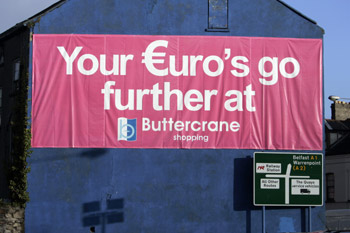Shoppers begin to shun north

While the Greek financial crisis was bad news for bond traders, the resulting weakness in the euro provided Irish retailers with their first good news for a long time
13 May 2010
Although the European finance minister has now agreed a new bailout plan amounting to €720 billion to restore confidence in the credibility of the euro, the Greek crisis showed just how vulnerable the single currency is. Bailing out Greece to the tune of €110 billion represented the most severe crisis to hit the euro in its eleven-and-a-half year existence. For the first time serious questions were being asked about the future of the euro.
Euro falling on foreign exchanges
As Greece has lurched from one disaster to another and the EU was dithering with a response to the crisis, the value of the euro fell on the foreign exchanges.
By the beginning of this month the euro had fallen to $1.32 and 86p. Given that we do most of our trade with the US and UK that was very good news for this country.
And not before time
2009 is a year that will live in infamy for Irish retailers with consumer sales dropping 14% by volume and 18% by value. While the economic collapse was the main reason for this sharp downturn in consumer sales, cross-border shopping also played a major role.
By last November an estimated 4.4% of southern grocery shopping was being done in the North. And with good reason. The collapse in the value of sterling in the second half of 2008 and British Chancellor Alistair Darling’s emergency cut in the UK VAT rate from 17.5% to 15% opened up a huge price gap between north and south.
The border effect

Cross-border shopping
In late 2009 a price survey conducted by the Consumer Association of Ireland found that a basket of groceries was 18% dearer in one of Tesco’s Republic of Ireland outlets than it was in a Tesco shop north of the border.
Quite clearly something had to give. In his December 2009 budget Minister for Finance Brian Lenihan moved decisively to address the cross-border price disparity by slashing the excise duty on alcohol by a fifth. While this move didn’t entirely eliminate the price advantage enjoyed by Northern retailers it restored something resembling a level playing field.
Then in January of this year the temporary cut in the UK VAT rate expired and it went back up to 17.5%. Coming on top of the 0.5% cut in the Southern VAT rate to 21%, this meant that the VAT gap between North and South narrowed from a yawning 6.5% to an altogether more manageable 3.5%.
And it’s almost certainly going to get a great deal narrower. With the British public finances looking almost as ropey as our own it’s a racing certainty that whoever wins the UK general election on 6 May will have to bring in an emergency budget shortly afterwards.
This is likely to feature a raft of tax increases. Top of the list is likely to be an increase in the UK VAT rate to 20% and possibly higher excise duties on tobacco and alcohol as well. A higher British VAT rate and dearer booze and fags would further erode the price gap between North and South.
Is the worst over for Southern retailers?
With dearer sterling already feeding through into higher prices north of the border, it seems as if the worst is over for Southern retailers. The huge price disparity that existed from late 2008 to late 2009 has largely disappeared. This is already making itself apparent in the retail sales figures with the most recent data showing a 3% annual increase. Even when the jump in motor sales caused by the scrappage scheme is filtered out, the annual growth in retail sales is still running at 2.5%.
A hefty hike in the UK VAT rate and excise duties would further tilt the balance of advantage in favour of Southern retailers.
Still it might not be a good idea for Southern retailers to get too carried away. The latest survey from IBEC’s Retail Ireland offshoot shows that most retailers are still under severe pressure.
Not out of the woods yet
According to the Retail Ireland survey, 48% of retailers rated the prospects for their business in the second quarter as either poor or very poor. Another standout result from the survey was that over a fifth of all retailers expected to shed staff in the second quarter while over three-quarters would not be hiring any new staff.
It is now clear that, following the increases imposed during the boom years, both retail rents and commercial rates are totally out of kilter with the new reality. The Irish minimum wage of €8.65 per hour is the second highest in Europe and is almost a third higher than the UK minimum wage of Stg£5.80 (€6.70) per hour.
While the creation of new upward-only leases has been banned, the government has obstinately refused to face down its property developer supporters and scrap upward-only rent reviews on existing leases. The minimum wage also appears to be sacrosanct – a sort of holy relic from the “social partnership” years.
All of which means, is that with the value of retail sales down by almost a quarter from their late-2007 peak, any recovery in retailing will be very gradual. With taxes likely to rise significantly in next December’s budget the retail sector looks set to bump along the bottom for many years to come.



 Print
Print






Fans 0
Followers